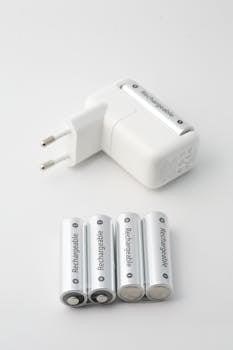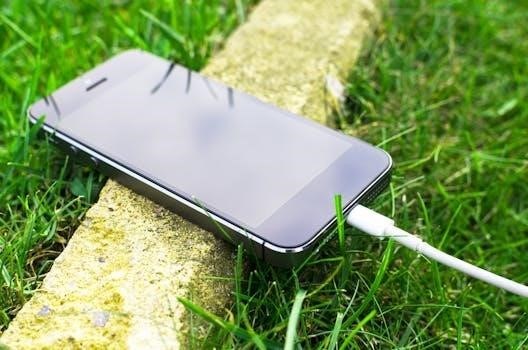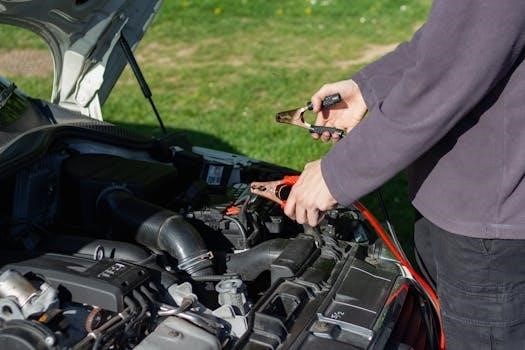schumacher battery charger manual sul code
- Published
- in Manuals
Schumacher battery chargers are essential for maintaining vehicle batteries, offering various features including desulfation capabilities. The ‘SUL’ code indicates the charger has detected a sulfated battery, a common issue. This manual contains important safety and operating instructions.
Understanding the Importance of Battery Charger Manuals
Battery charger manuals, such as those provided by Schumacher, are crucial resources for safe and effective battery maintenance. These manuals provide key safety precautions, ensuring users avoid risks of fire, electric shock, or personal injury. They detail the proper operating procedures for the specific charger model, which vary in features and functionalities like desulfation modes and error code interpretations. Understanding these instructions is essential for maximizing the lifespan of both the charger and the batteries being charged. Moreover, manuals often include troubleshooting guides that can help users identify and resolve common problems, like the ‘SUL’ error code, which indicates a sulfated battery. Neglecting the manual can lead to improper usage, potentially causing damage to the battery, the charger, or even creating hazardous situations. Therefore, it’s vital to read and follow the guidelines in the manual before each use. These manuals also explain maintenance and care, keeping your charger working properly for years.

Decoding the ‘SUL’ Error Code
The ‘SUL’ error code on a Schumacher battery charger signifies that the device has detected a sulfated battery. This condition requires a specific desulfation process to rectify.
What ‘SUL’ Indicates⁚ Battery Sulfation
When a Schumacher battery charger displays the ‘SUL’ code, it’s a clear indication that the connected battery is experiencing sulfation. Sulfation is a common phenomenon that occurs in lead-acid batteries, often due to prolonged periods of undercharging or inactivity. This process involves the formation of lead sulfate crystals on the battery’s plates, hindering the flow of electrical current. Over time, these crystals accumulate, reducing the battery’s capacity and its ability to hold a charge effectively. The presence of sulfation can significantly impact battery performance, leading to reduced cranking power and a shortened lifespan. The ‘SUL’ code serves as a warning that the battery requires a desulfation process to reverse the crystal buildup and restore its optimal functionality. This issue commonly affects car batteries and similar lead-acid types. Addressing sulfation promptly can help extend the life of the battery and prevent premature replacement. Therefore, recognizing the ‘SUL’ indicator is crucial for maintaining battery health.
How Sulfation Affects Battery Performance
Battery sulfation significantly degrades a battery’s performance, primarily by reducing its ability to store and deliver energy. The formation of lead sulfate crystals on the battery plates acts as an insulator, impeding the electrochemical reactions necessary for charging and discharging. This leads to a noticeable decrease in the battery’s capacity, meaning it cannot hold as much charge as it used to. As sulfation progresses, the battery’s internal resistance increases, causing it to heat up more during use and charge. The higher resistance also results in a reduced cranking power, making it more difficult to start a vehicle, especially in cold weather. Over time, sulfation accelerates the deterioration of the battery, shortening its overall lifespan. This can lead to frequent battery replacements, impacting both convenience and cost. Recognizing the symptoms of sulfation and addressing them with a desulfation process is essential to maintain optimal battery performance and longevity. Ignoring sulfation can lead to total battery failure.
Schumacher Charger’s Desulfation Process
Schumacher chargers address sulfation through a specific desulfation mode. This process uses a low charging current to break down lead sulfate crystals, aiming to restore battery performance and capacity.
The Charger’s Response to a Sulfated Battery
When a Schumacher battery charger detects a sulfated battery, indicated by the ‘SUL’ code on the display, it automatically initiates a desulfation process. This process involves the charger switching to a specialized mode designed to address the buildup of lead sulfate crystals on the battery plates. The charger will provide a very low charging current, carefully attempting to break down these crystals without causing damage. During this phase, the display will show ‘SUL’, and in some models, a ‘BAD BATTERY’ LED might illuminate. The charger monitors the battery’s response and continues the desulfation process as long as progress is detected. If the battery fails to respond to desulfation efforts, the charger may then go into abort mode, indicating the need for further battery evaluation. The desulfation mode is a key feature of Schumacher chargers, helping to extend the life of batteries.
Duration and Conditions of Desulfation Mode
The duration of the desulfation mode on a Schumacher battery charger varies, but it typically lasts up to 10 hours, depending on the model and the severity of the sulfation. During this time, the charger provides a low charging current, while closely monitoring the battery’s condition. The desulfation process requires patience, as it is designed to gently break down the sulfate crystals without causing harm. The charger must be connected to the battery with a good connection to work effectively. The ambient temperature and the initial state of the battery can also affect the time required to complete desulfation. If the desulfation process is successful, the charger will switch to normal charging mode. If the charger does not detect a successful desulfation the charger will show the error code F02, and charging will abort.

Troubleshooting and Error Codes Beyond ‘SUL’
Besides the ‘SUL’ code, Schumacher chargers display other error codes like ‘F02’ and ‘F03’, which indicate charging issues. These codes help diagnose problems, enabling users to take the necessary corrective actions.
Other Common Error Codes (F02, F03)
Beyond the ‘SUL’ code, Schumacher battery chargers may display other error codes, notably ‘F02’ and ‘F03’, which signal specific issues encountered during the charging process. The ‘F02’ error typically indicates that the charger has failed to desulfate the battery. This often suggests the battery may be too damaged to recover, needing replacement or professional assessment. In such instances, the charger will usually abort the charging process, as it cannot complete its intended function. On the other hand, the ‘F03’ error code usually means that the battery was unable to reach its full charge capacity. This can be due to a variety of factors, including a faulty battery cell or other internal issues. When these error codes appear, users should not attempt further charging and should have the battery evaluated or replaced as needed to ensure safety and reliable performance.
Interpreting Error Messages and Solutions
Understanding Schumacher battery charger error messages is crucial for effective troubleshooting. When the display shows ‘SUL,’ it signifies battery sulfation, initiating the charger’s desulfation mode which can take up to 10 hours. If the desulfation process fails, the charger might display ‘F02’, meaning the battery could not be desulfated. In such cases, the battery may be beyond recovery and require replacement. An ‘F03’ error code appears if the battery fails to reach a full charge, indicating potential battery damage or an issue with the battery. When encountering these errors, always ensure proper terminal connections and use a true RMS meter for voltage checks. If issues persist, discontinue charging and consider having the battery assessed by a professional to prevent further complications. Following the manual’s safety instructions is paramount for safe operation.

Safety Instructions and Maintenance
Always follow safety instructions in the manual, keeping the charger away from children and moisture. Regularly clean clamps and ensure proper connections. This will help maintain the charger’s performance and longevity.
Key Safety Precautions from the Manual
The Schumacher battery charger manual emphasizes several key safety precautions to prevent injury, fire, or electric shock. It is crucial to keep the charger out of reach of children, ensuring they do not tamper with the device or its connections. Never expose the charger to rain or snow, as moisture can lead to electrical hazards and damage the internal components. The use of attachments not recommended or sold by the manufacturer is strictly discouraged, as they may pose a risk of fire, electric shock, or personal injury. Always read and understand the safety instructions provided in the manual before each use. This manual contains important safety and operating instructions. Inspect the charger, cables, and clamps for any damage before use. Ensure the clamps are securely connected to the battery terminals, with the correct polarity (+ to + and ⏤ to -). Do not use the charger if any part is damaged or if it is not working correctly. It is essential to follow these precautions to ensure safe operation and avoid potential hazards.
Proper Maintenance for Long-Term Charger Use
To ensure your Schumacher battery charger operates effectively and lasts for years, regular maintenance is essential. After each use, clean the clamps to remove any battery fluid or corrosion which can impair electrical contact. This simple step will help ensure optimal performance. Store the charger in a dry location, away from extreme temperatures and moisture, which can damage internal components. Avoid storing the charger with tangled cords, as this can lead to damage. Inspect the charger, cables, and clamps regularly for any signs of wear or damage. If you notice any damage, do not use the charger and seek professional repair. Ensure the charger’s ventilation openings are clear of any obstructions to allow proper cooling and prevent overheating. Following these maintenance tips will help keep your charger in good working condition and extend its lifespan. Proper care will ensure the charger functions correctly when needed.

Additional Features of Schumacher Chargers
Schumacher chargers offer features like auto voltage detection, ensuring safe charging by automatically identifying battery voltage. They also provide maintenance charging to keep batteries at optimal levels during storage periods.
Auto Voltage Detection
Schumacher battery chargers are equipped with an automatic voltage detection feature, a crucial component for safe and efficient charging. This technology allows the charger to intelligently identify the voltage of the connected battery, whether it’s a 6V or 12V system. This eliminates the risk of overcharging or undercharging, which can severely damage a battery or hinder its performance. The charger automatically adjusts its charging parameters based on the detected voltage, ensuring the battery receives the correct charge rate. The auto voltage detection is a convenience, simplifying the charging process for users, and also it adds a layer of safety and protection to the charging cycle. By not requiring manual voltage selection, the risk of user error is minimized. This feature is particularly helpful when dealing with various battery types or when the user is unsure of the battery’s exact voltage specification. This ensures proper charging and maximizes the battery’s lifespan.
Maintenance Charging
Schumacher battery chargers feature maintenance charging, a vital function for keeping batteries in optimal condition during storage or periods of infrequent use. Maintenance charging, often referred to as float charging, involves delivering a very low current to the battery. This helps to counteract the natural self-discharge that occurs over time, preventing the battery from losing its charge and becoming sulfated. This feature ensures that the battery is always ready for use when needed. By maintaining the battery at its full charge level, maintenance charging extends the battery’s lifespan. This avoids the issues associated with undercharged batteries, such as reduced capacity and increased sulfation. The charger automatically enters maintenance mode after the battery has been fully charged, providing continuous and safe charging. This mode also prevents overcharging, by adjusting its current to match what is necessary to maintain the battery’s full charge. This ensures the battery remains in peak condition, ready for use at any time.
